Clustering Algorithms and Validation Indices for a Wide mmWave Spectrum †
Abstract
1. Introduction
2. Clustering Concepts and Simulation Environment
2.1. Clustering for Channel Modeling
2.2. Cluster Validity Indices
2.3. Using Multiple CVIs to Compare Clustering Solutions
2.4. Simulation Setup
3. Simulation Results
3.1. Clustering Algorithm Results
3.2. Clustering Validation Using CVIs and Score Fusion Results
3.3. The Effect of Increased Frequency in the mmWave Spectrum
3.4. The Effect of Antenna Beamwidth
3.5. Cluster Characteristics
4. Conclusions
Author Contributions
Funding
Acknowledgments
Conflicts of Interest
Abbreviations
| CDF | Cumulative Distribution Function |
| CIR | Channel Impulse Response |
| CVI | Cluster Validity Index |
| AoA | Angle-of-Arrival |
| AoD | Angle-of-Departure |
| HPBW | Half-Power Beamwidth |
| LOS | Line-of-Sight |
| mmWave | Millimeter Wave |
| MPC | Multipath Component |
| NLOS | Non-Line-of-Sight |
| RMS | Root Mean Square |
| Rx | Receiver |
| ToA | Time-of-Arrival |
| Tx | Transmitter |
References
- Niu, Y.; Li, Y.; Jin, D.; Su, L.; Vasilakos, A.V. A Survey of Millimeter Wave Communications (mmWave) for 5G: Opportunities and Challenges. Wirel. Networks 2015, 21, 2657–2676. [Google Scholar] [CrossRef]
- Rappaport, T.S.; Sun, S.; Mayzus, R.; Zhao, H.; Azar, Y.; Wang, K.; Wong, G.N.; Schulz, J.K.; Samimi, M.K.; Gutierrez, F. Millimeter Wave Mobile Communications for 5G Cellular: It Will Work! IEEE Access 2013, 1, 335–349. [Google Scholar] [CrossRef]
- Gustafson, C.; Bolin, D.; Tufvesson, F. Modeling the Cluster Decay in mm-Wave Channels. In Proceedings of the EuCAP 2014, Hague, The Netherlands, 6–11 April 2014; pp. 804–808. [Google Scholar]
- Shutin, D. Cluster Analysis of Wireless Channel Impulse Responses. In Proceedings of the International Zurich Seminar on Communications, Zurich, Switzerland, 18–20 February 2004; pp. 124–127. [Google Scholar]
- Samimi, M.K.; Rappaport, T.S. 3-D Statistical Channel Model for Millimeter-Wave Outdoor Mobile Broadband Communications. In Proceedings of the IEEE ICC 2015, London, UK, 8–12 June 2015; pp. 2430–2436. [Google Scholar]
- Hamerly, G.; Elkan, C. Alternatives to the k-Means Algorithm that Find Better Clusterings. In Proceedings of the CIKM 2002, McLean, VA, USA, 4–9 November 2002; pp. 600–607. [Google Scholar]
- Hastie, T.; Tibshirani, R.; Friedman, J.H. The Elements of Statistical Learning: Data Mining, Inference, and Prediction, 2nd ed.; Springer: Berlin/Heidelberg, Germany, 2016. [Google Scholar]
- Martinez-Ingles, M.T.; Gaillot, D.P.; Pascual-Garcia, J.; Molina Garcia-Pardo, J.M.; Lienard, M.; Rodríguez, J.V.; Juan-Llacer, L. Impact of Clustering at mmW Band Frequencies. In Proceedings of the IEEE International Symposium on Antennas and Propagation & USNC/URSI National Radio Science Meeting, Vancouver, BC, Canada, 19–24 July 2015; pp. 1009–1010. [Google Scholar]
- Gustafson, C.; Haneda, K.; Wyne, S.; Tufvesson, F. On mm-Wave Multipath Clustering and Channel Modeling. IEEE Trans. Antennas Propag. 2014, 62, 1445–1455. [Google Scholar] [CrossRef]
- Czink, N.; Cera, P.; Salo, J.; Bonek, E.; Nuutinen, J.P.; Ylitalo, J. A Framework for Automatic Clustering of Parametric MIMO Channel Data Including Path Powers. In Proceedings of the IEEE VTC Fall 2006, Montreal, QC, Canada, 25–28 September 2006; pp. 1–5. [Google Scholar]
- Czink, N.; Tian, R.; Wyne, S.; Tufvesson, F.; Nuutinen, J.P.; Ylitalo, J.; Bonek, E.; Molisch, A.F. Tracking Time-Variant Cluster Parameters in MIMO Channel Measurements. In Proceedings of the CHINACOM 2007, Shanghai, China, 22–24 August 2007; pp. 1147–1151. [Google Scholar]
- Czink, N.; Cera, P.; Salo, J.; Bonek, E.; Nuutinen, J.P.; Ylitalo, J. Improving clustering performance using multipath component distance. Electron. Lett. 2006, 42, 33–45. [Google Scholar] [CrossRef]
- Caliński, T.; Harabasz, J. A Dendrite Method for Cluster Analysis. Commun. Stat. 1974, 3, 1–27. [Google Scholar]
- Davies, D.L.; Bouldin, D.W. A Cluster Separation Measure. IEEE Trans. Pattern Anal. Mach. Intell. 1979, PAMI-1, 224–227. [Google Scholar] [CrossRef]
- Bezdek, J.C.; Pal, N.R. Some new indexes of cluster validity. IEEE Trans. Syst. Man Cybern. 1998, 28, 301–315. [Google Scholar] [CrossRef] [PubMed]
- Dunn, J.C. A fuzzy relative of the ISODATA process and its use in detecting compact well-separated clusters. J. Cybern. 1973, 3, 32–57. [Google Scholar] [CrossRef]
- Xie, X.L.; Beni, G. A validity measure for fuzzy clustering. IEEE Trans. Pattern Anal. Mach. Intell. 1991, 13, 841–847. [Google Scholar] [CrossRef]
- Pakhira, M.K.; Bandyopadhyay, S.; Maulik, U. Validity index for crisp and fuzzy clusters. Pattern Recognit. 2004, 37, 487–501. [Google Scholar] [CrossRef]
- Tehrani Moayyed, M.; Antonescu, B.; Basagni, S. Clustering Validation for mmWave Multipath Components in Outdoor Transmissions. In Proceedings of the WD 2019, Manchester, UK, 24–26 April 2019; pp. 1–8. [Google Scholar]
- Kryszczuk, K.; Hurley, P. Estimation of the Number of Clusters Using Multiple Clustering Validity Indices. In Proceedings of the 9th International Workshop on Multiple Classifier Systems, LNCS, Cairo, Egypt, 7–9 April 2010; Volume 5997, pp. 114–123. [Google Scholar]
- BridgeWave Unveils BW64 60 GHz Wireless Backhaul Solutions. Available online: https://bridgewave.com/bridgewave-unveils-bw64-60-ghz-wireless-backhaul-solutions/ (accessed on 3 April 2015).
- Rangan, S.; Rappaport, T.S.; Erkip, E. Millimeter-Wave Cellular Wireless Networks: Potentials and Challenges. Proc. IEEE 2014, 102, 366–385. [Google Scholar] [CrossRef]
- Tehrani Moayyed, M.; Antonescu, B.; Basagni, S. Clustering Algorithms and Validation Indices for mmWave Radio Multipath Propagation. In Proceedings of the WTS2019, Manchester, UK, 24–26 April 2019; pp. 1–7. [Google Scholar]
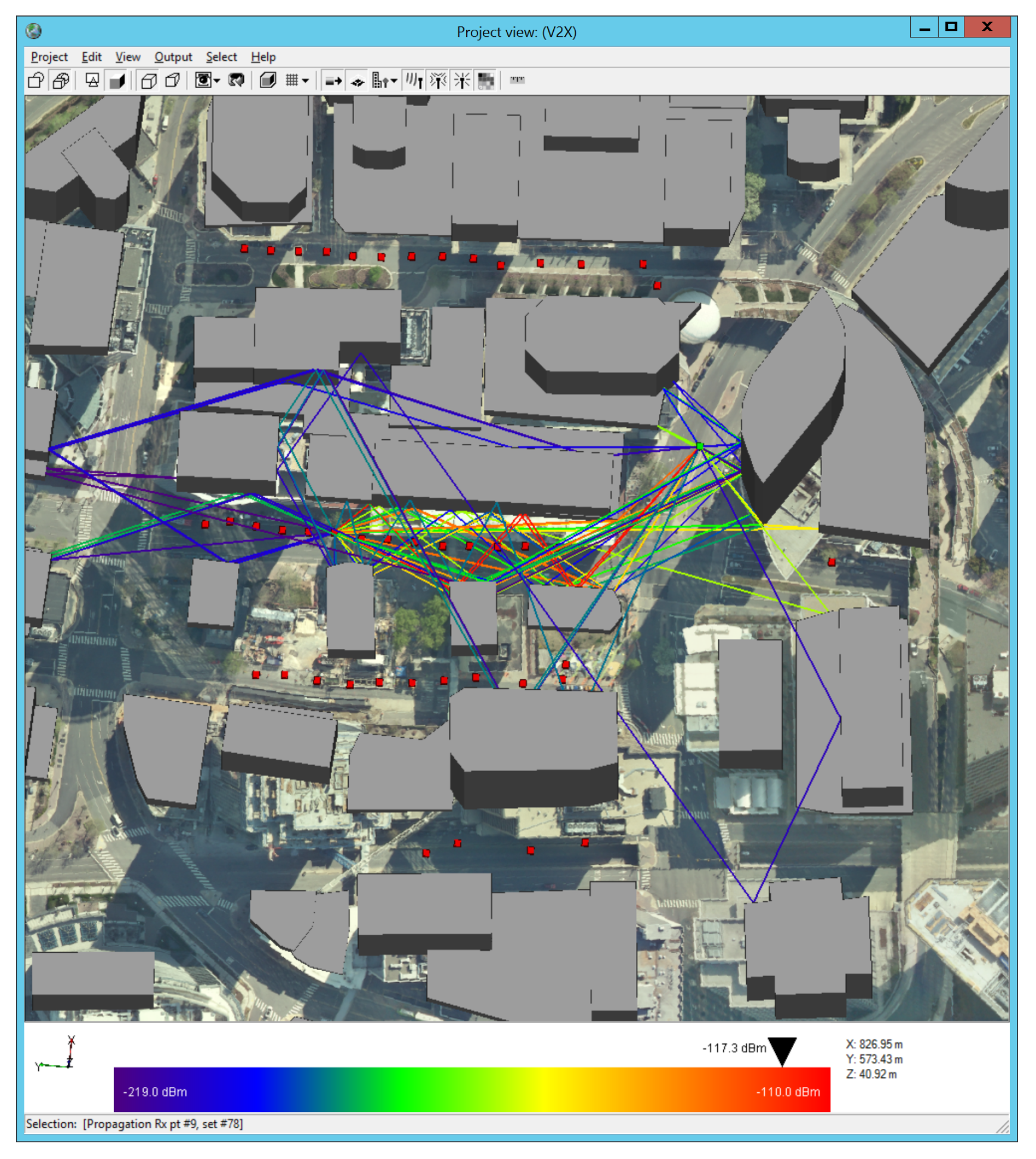
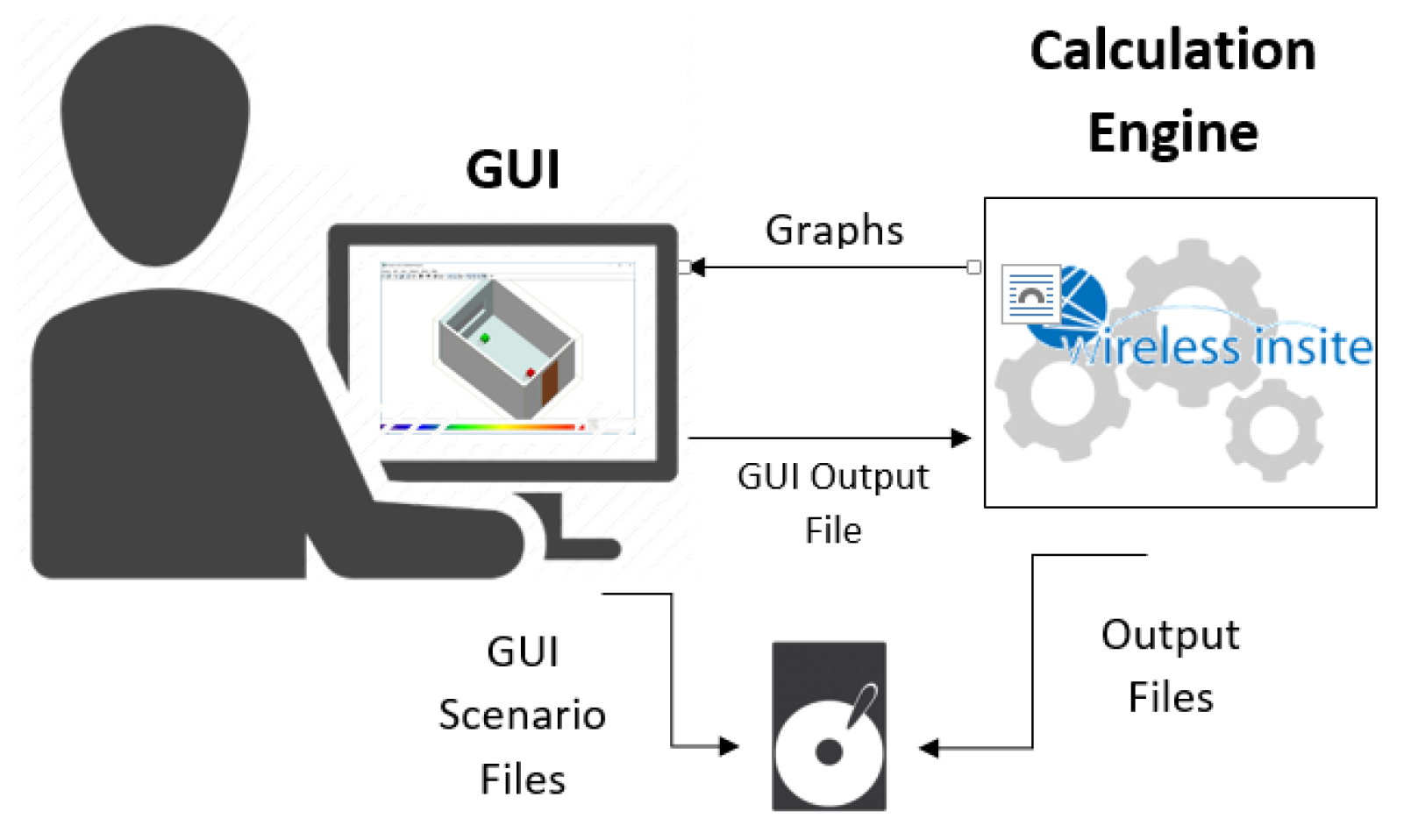
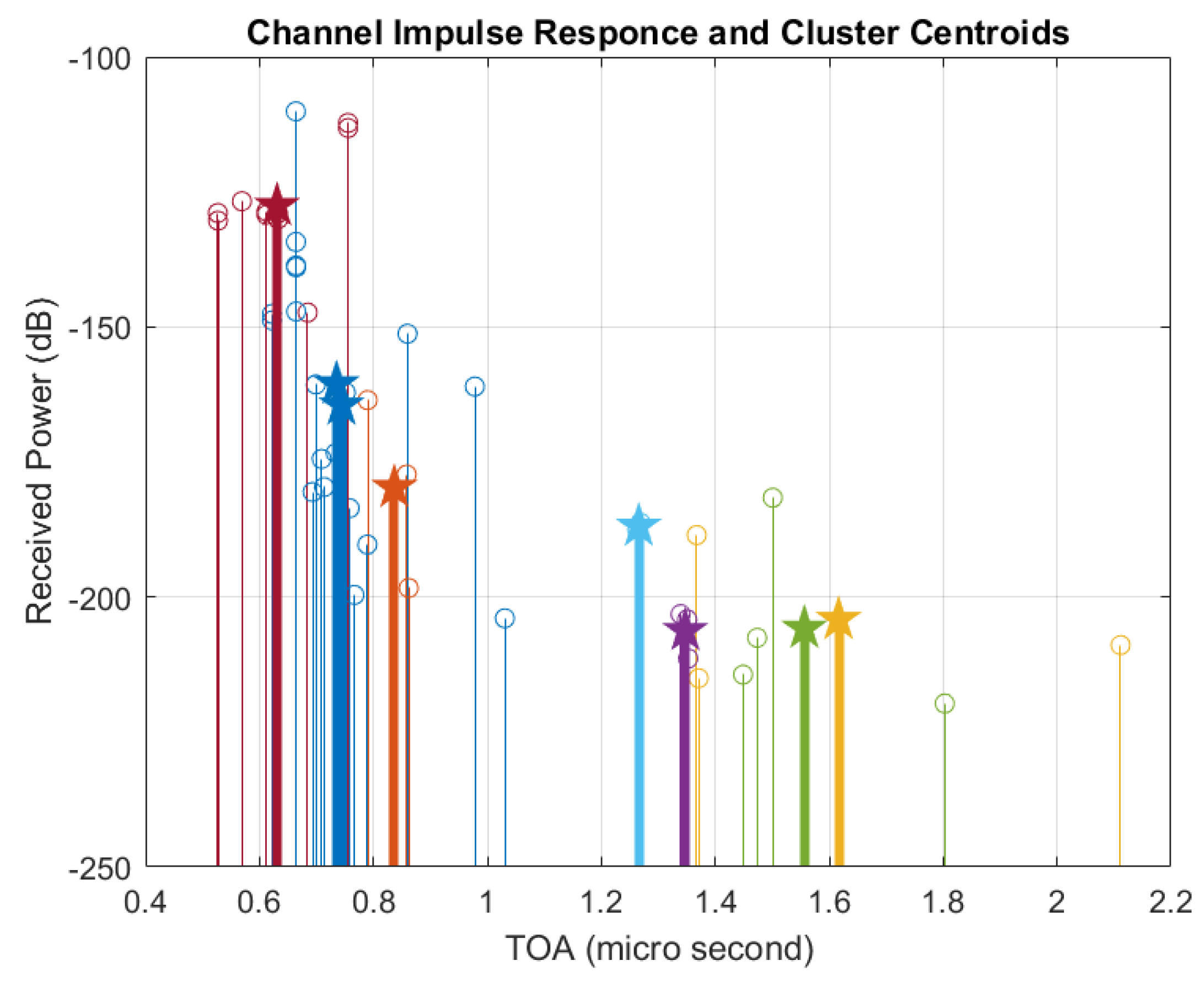
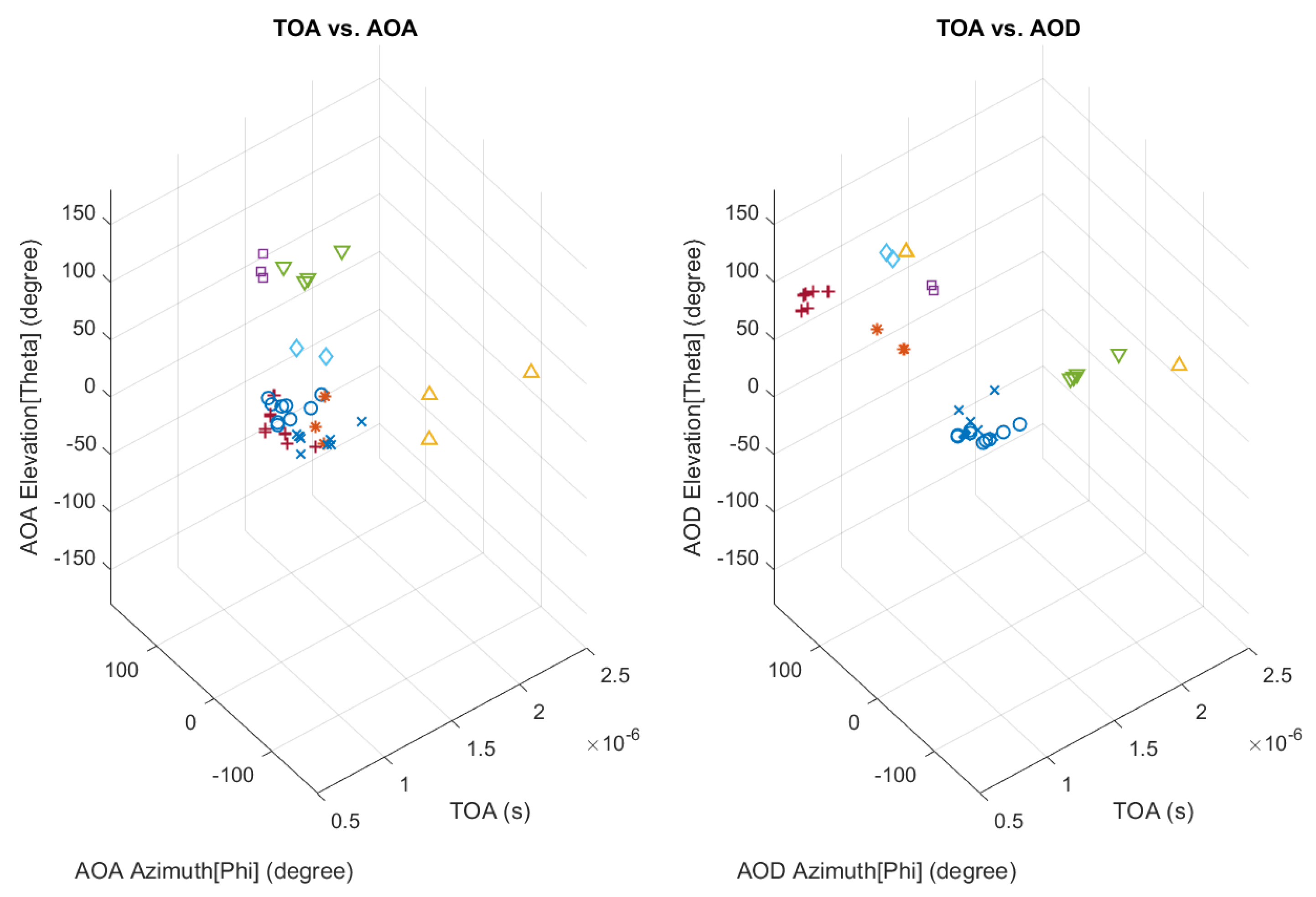

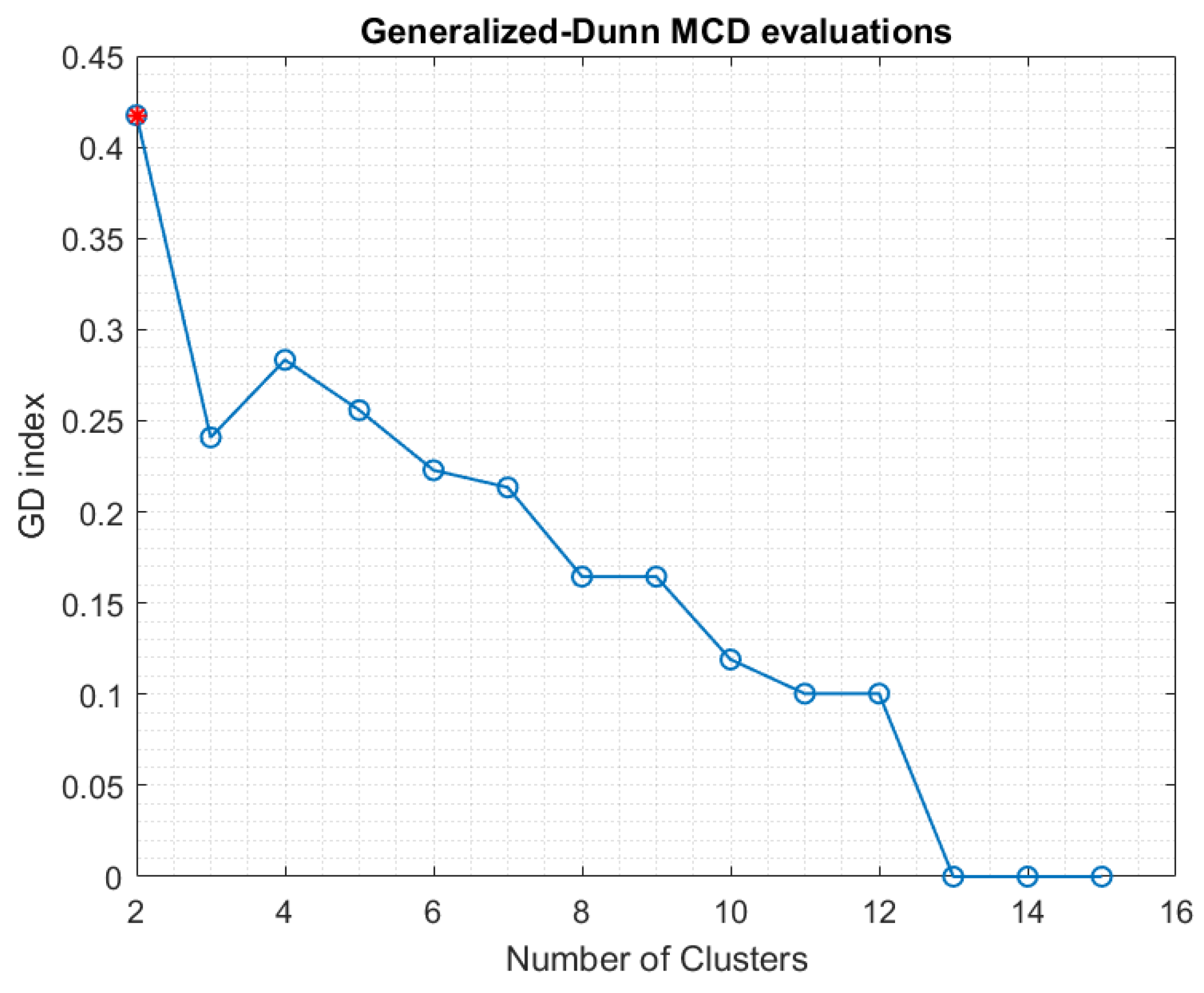
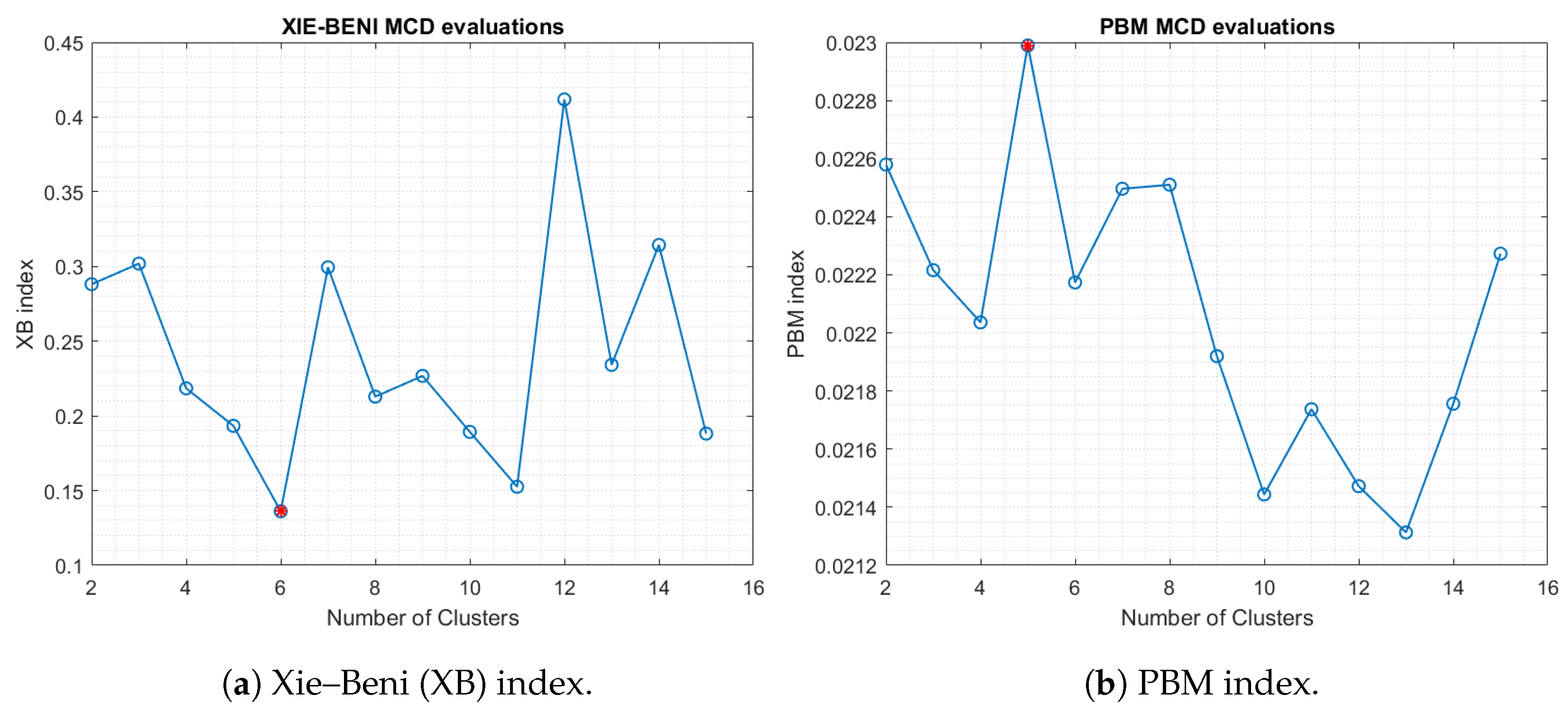
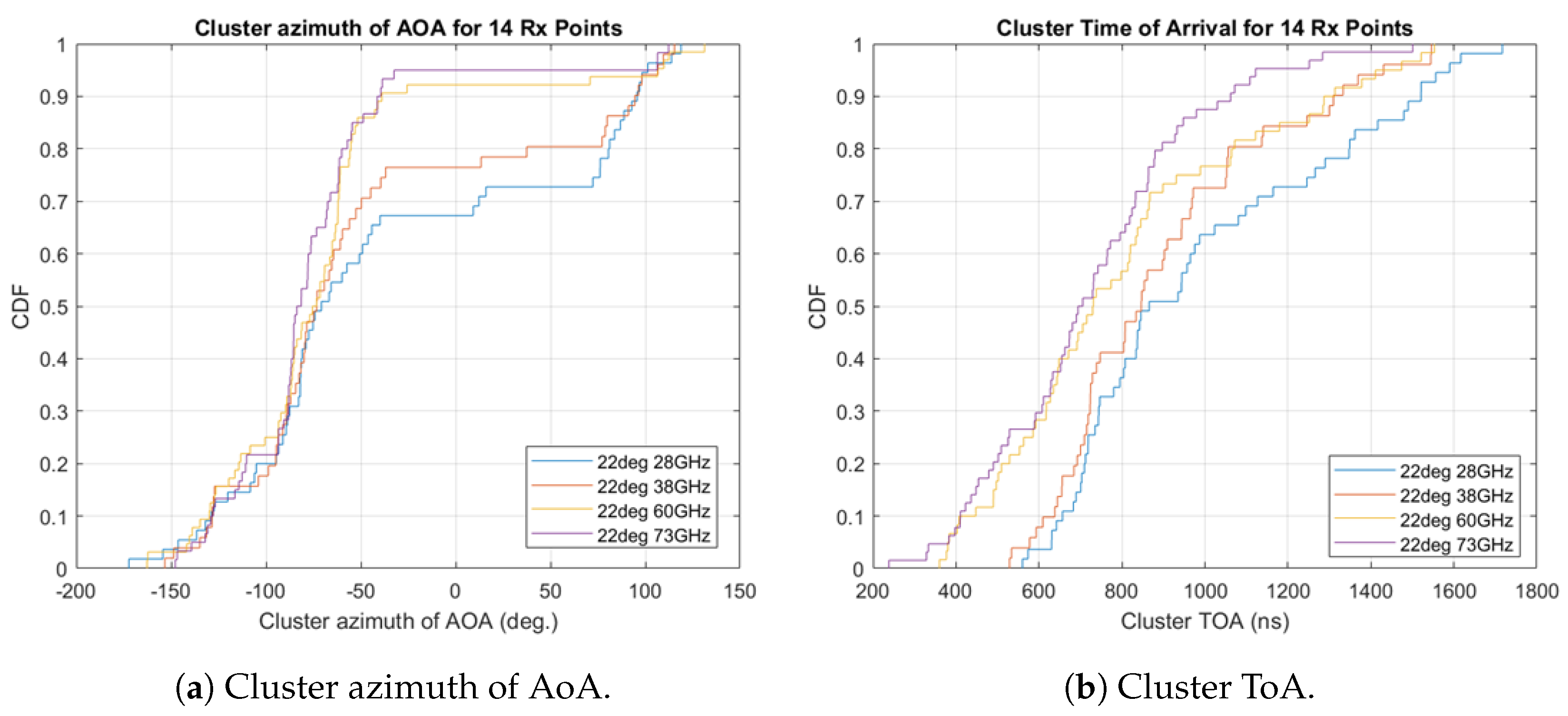

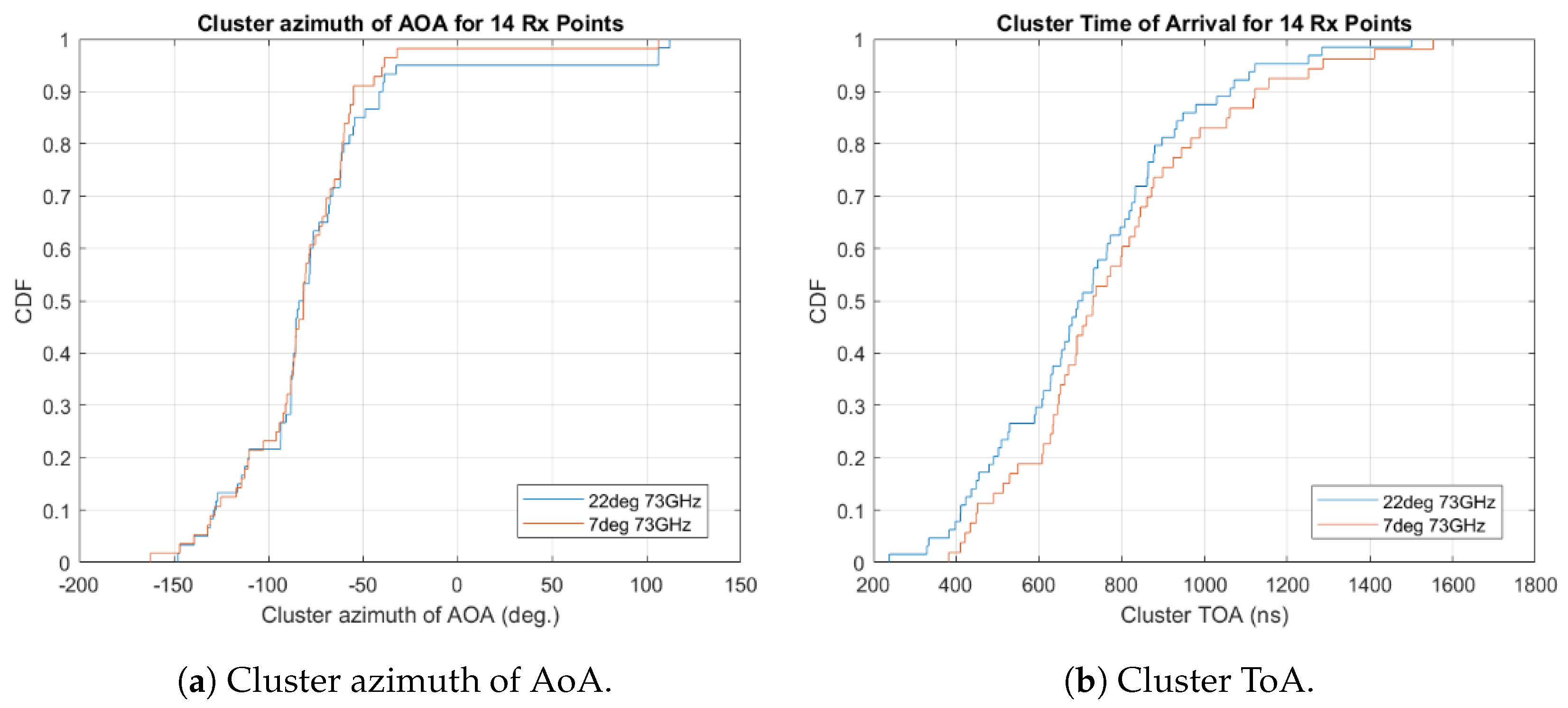
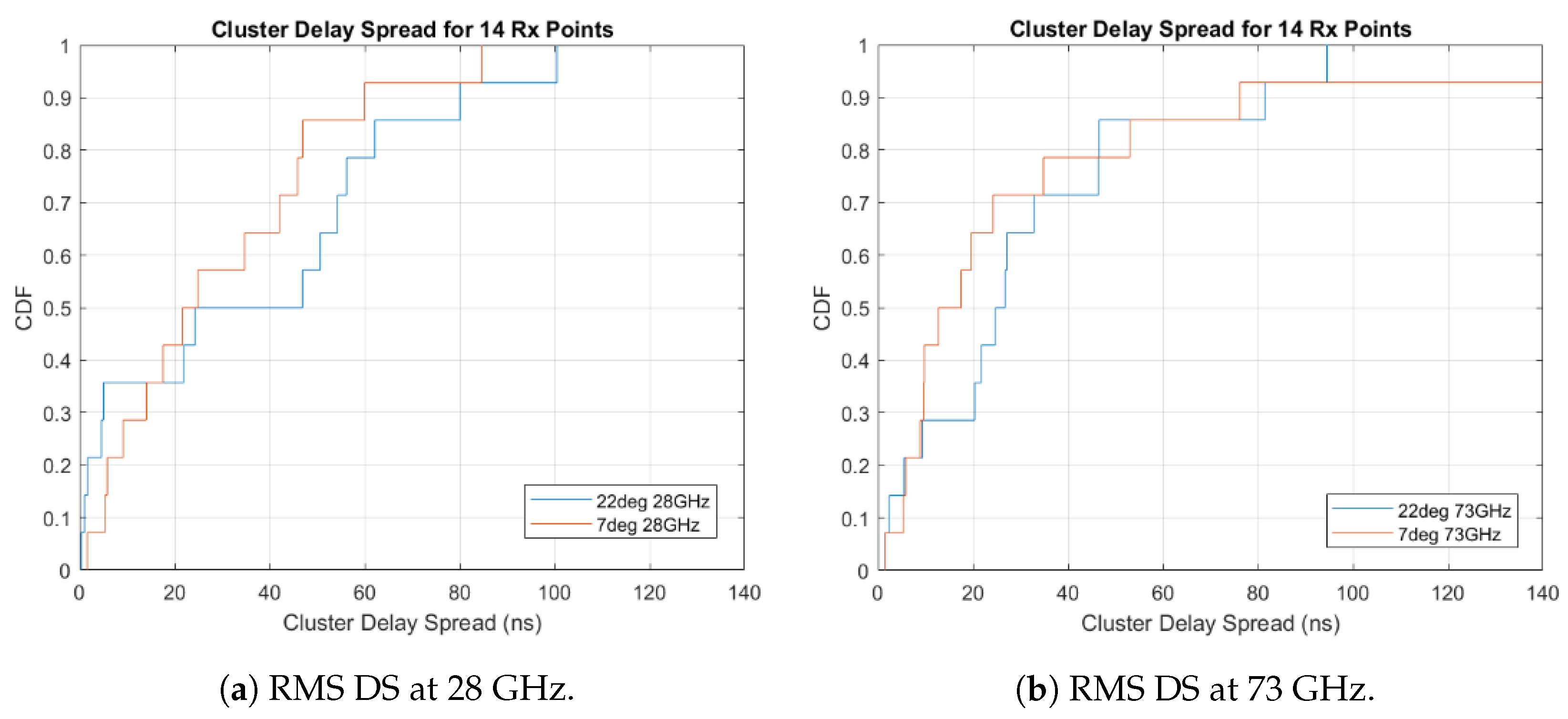
| K | CH | XB | PBM | DB | GD | ||||
|---|---|---|---|---|---|---|---|---|---|
| 2 | 0.000 | 0.449 | 0.755 | 1.000 | 1.000 | 0.641 | 0.000 | 0.000 | 0.214 |
| 3 | 0.166 | 0.399 | 0.539 | 0.911 | 0.577 | 0.518 | 0.451 | 0.378 | 0.449 |
| 4 | 0.100 | 0.702 | 0.431 | 0.772 | 0.679 | 0.537 | 0.437 | 0.303 | 0.426 |
| 5 | 0.133 | 0.793 | 1.000 | 0.724 | 0.613 | 0.653 | 0.542 | 0.391 | 0.529 |
| 6 | 0.213 | 1.000 | 0.513 | 0.676 | 0.534 | 0.587 | 0.524 | 0.454 | 0.522 |
| 7 | 0.358 | 0.408 | 0.706 | 0.517 | 0.511 | 0.500 | 0.486 | 0.474 | 0.487 |
| 8 | 0.540 | 0.722 | 0.714 | 0.518 | 0.394 | 0.578 | 0.564 | 0.549 | 0.563 |
| 9 | 0.631 | 0.671 | 0.362 | 0.358 | 0.394 | 0.483 | 0.464 | 0.448 | 0.465 |
| 10 | 0.691 | 0.807 | 0.078 | 0.368 | 0.285 | 0.446 | 0.340 | 0.230 | 0.339 |
| 11 | 0.819 | 0.940 | 0.253 | 0.297 | 0.240 | 0.510 | 0.425 | 0.363 | 0.433 |
| 12 | 0.810 | 0.000 | 0.095 | 0.051 | 0.240 | 0.239 | 0.000 | 0.000 | 0.080 |
| 13 | 0.844 | 0.644 | 0.000 | 0.148 | 0.000 | 0.327 | 0.000 | 0.000 | 0.109 |
| 14 | 0.872 | 0.353 | 0.264 | 0.000 | 0.000 | 0.298 | 0.000 | 0.000 | 0.099 |
| 15 | 1.000 | 0.811 | 0.572 | 0.147 | 0.000 | 0.506 | 0.000 | 0.000 | 0.169 |
| Rx | CH | XB | PBM | DB | GD | ||||
|---|---|---|---|---|---|---|---|---|---|
| 1 | 5 | 9 | 2 | 2 | 2 | 4 | 4 | 4 | 4 |
| 2 | 4 | 6 | 3 | 2 | 2 | 4 | 4 | 4 | 4 |
| 3 | 2 | 23 | 2 | 2 | 2 | 2 | 2 | 2 | 2 |
| 4 | 19 | 18 | 3 | 2 | 2 | 3 | 3 | 3 | 3 |
| 5 | 21 | 17 | 2 | 2 | 2 | 3 | 3 | 3 | 3 |
| 6 | 18 | 18 | 3 | 2 | 2 | 5 | 5 | 5 | 5 |
| 7 | 18 | 18 | 4 | 2 | 2 | 4 | 4 | 4 | 4 |
| 8 | 18 | 6 | 3 | 2 | 2 | 3 | 4 | 4 | 4 |
| 9 | 15 | 6 | 5 | 2 | 2 | 5 | 8 | 8 | 8 |
| 10 | 19 | 4 | 4 | 2 | 2 | 4 | 4 | 5 | 4 |
| 11 | 15 | 6 | 3 | 2 | 2 | 3 | 3 | 3 | 3 |
| 12 | 15 | 5 | 3 | 2 | 2 | 3 | 3 | 3 | 3 |
| 13 | 17 | 8 | 4 | 2 | 2 | 4 | 4 | 4 | 4 |
| 14 | 14 | 7 | 14 | 3 | 2 | 3 | 4 | 4 | 4 |
| (a) Number of MPCs for All 14 Rx Locations | (b) Optimal K Value for All 14 Rx Locations | |||||||||
|---|---|---|---|---|---|---|---|---|---|---|
| Number of MPCs | Optimal Number of Clusters K | |||||||||
| Rx | 28 GHz | 38 GHz | 60 GHz | 73 GHz | Rx | 28 GHz | 38 GHz | 60 GHz | 73 GHz | |
| 1 | 112 | 96 | 59 | 53 | 1 | 4 | 5 | 14 | 8 | |
| 2 | 85 | 72 | 48 | 40 | 2 | 4 | 4 | 7 | 6 | |
| 3 | 74 | 65 | 43 | 34 | 3 | 2 | 2 | 7 | 2 | |
| 4 | 56 | 46 | 33 | 32 | 4 | 3 | 3 | 3 | 9 | |
| 5 | 64 | 52 | 37 | 33 | 5 | 3 | 5 | 3 | 4 | |
| 6 | 63 | 53 | 35 | 31 | 6 | 5 | 4 | 4 | 4 | |
| 7 | 54 | 41 | 30 | 27 | 7 | 4 | 4 | 4 | 4 | |
| 8 | 57 | 43 | 32 | 30 | 8 | 4 | 3 | 3 | 3 | |
| 9 | 44 | 35 | 28 | 24 | 9 | 8 | 3 | 6 | 2 | |
| 10 | 59 | 53 | 33 | 30 | 10 | 4 | 3 | 2 | 2 | |
| 11 | 44 | 39 | 26 | 26 | 11 | 3 | 3 | 3 | 3 | |
| 12 | 44 | 39 | 27 | 26 | 12 | 3 | 3 | 2 | 4 | |
| 13 | 51 | 42 | 30 | 27 | 13 | 4 | 4 | 3 | 5 | |
| 14 | 41 | 33 | 23 | 21 | 14 | 4 | 5 | 3 | 4 | |
| Rx | CH | XB | PBM | DB | GD | ||||
|---|---|---|---|---|---|---|---|---|---|
| 1 | 30 | 6 | 5 | 2 | 2 | 5 | 5 | 5 | 5 |
| 2 | 4 | 6 | 4 | 2 | 2 | 4 | 4 | 4 | 4 |
| 3 | 2 | 19 | 2 | 2 | 2 | 2 | 2 | 2 | 2 |
| 4 | 15 | 14 | 3 | 2 | 2 | 3 | 3 | 3 | 3 |
| 5 | 16 | 16 | 4 | 2 | 2 | 4 | 5 | 5 | 5 |
| 6 | 17 | 15 | 5 | 2 | 2 | 5 | 5 | 4 | 5 |
| 7 | 14 | 14 | 4 | 2 | 3 | 4 | 4 | 4 | 4 |
| 8 | 16 | 12 | 3 | 2 | 2 | 4 | 4 | 4 | 4 |
| 9 | 12 | 6 | 3 | 2 | 2 | 2 | 4 | 4 | 4 |
| 10 | 18 | 5 | 3 | 2 | 2 | 3 | 3 | 3 | 3 |
| 11 | 6 | 5 | 3 | 2 | 2 | 3 | 3 | 3 | 3 |
| 12 | 13 | 4 | 3 | 2 | 2 | 3 | 3 | 3 | 3 |
| 13 | 14 | 7 | 14 | 2 | 2 | 4 | 4 | 4 | 4 |
| 14 | 11 | 7 | 11 | 2 | 2 | 11 | 5 | 6 | 5 |
| (a) Number of MPCs for All 14 Rx Locations | (b) Optimal K Value for All 14 Rx Locations | |||||||||
|---|---|---|---|---|---|---|---|---|---|---|
| Number of MPCs | Optimal Number of Clusters K | |||||||||
| Rx | 28 GHz | 38 GHz | 60 GHz | 73 GHz | Rx | 28 GHz | 38 GHz | 60 GHz | 73 GHz | |
| 1 | 100 | 89 | 60 | 50 | 1 | 5 | 5 | 5 | 7 | |
| 2 | 76 | 64 | 44 | 34 | 2 | 4 | 4 | 7 | 5 | |
| 3 | 64 | 55 | 37 | 32 | 3 | 2 | 4 | 6 | 6 | |
| 4 | 47 | 40 | 33 | 28 | 4 | 3 | 3 | 3 | 6 | |
| 5 | 54 | 45 | 34 | 31 | 5 | 5 | 5 | 4 | 4 | |
| 6 | 54 | 43 | 35 | 31 | 6 | 5 | 2 | 4 | 5 | |
| 7 | 42 | 36 | 27 | 25 | 7 | 4 | 5 | 4 | 3 | |
| 8 | 47 | 39 | 31 | 29 | 8 | 4 | 3 | 3 | 3 | |
| 9 | 37 | 31 | 24 | 23 | 9 | 4 | 7 | 2 | 2 | |
| 10 | 53 | 48 | 30 | 27 | 10 | 3 | 2 | 2 | 2 | |
| 11 | 40 | 36 | 26 | 24 | 11 | 3 | 3 | 3 | 3 | |
| 12 | 38 | 35 | 28 | 26 | 12 | 3 | 3 | 2 | 4 | |
| 13 | 41 | 37 | 30 | 30 | 13 | 4 | 3 | 3 | 3 | |
| 14 | 33 | 30 | 24 | 21 | 14 | 5 | 4 | 5 | 3 | |
© 2019 by the authors. Licensee MDPI, Basel, Switzerland. This article is an open access article distributed under the terms and conditions of the Creative Commons Attribution (CC BY) license (http://creativecommons.org/licenses/by/4.0/).
Share and Cite
Antonescu, B.; Tehrani Moayyed, M.; Basagni, S. Clustering Algorithms and Validation Indices for a Wide mmWave Spectrum. Information 2019, 10, 287. https://doi.org/10.3390/info10090287
Antonescu B, Tehrani Moayyed M, Basagni S. Clustering Algorithms and Validation Indices for a Wide mmWave Spectrum. Information. 2019; 10(9):287. https://doi.org/10.3390/info10090287
Chicago/Turabian StyleAntonescu, Bogdan, Miead Tehrani Moayyed, and Stefano Basagni. 2019. "Clustering Algorithms and Validation Indices for a Wide mmWave Spectrum" Information 10, no. 9: 287. https://doi.org/10.3390/info10090287
APA StyleAntonescu, B., Tehrani Moayyed, M., & Basagni, S. (2019). Clustering Algorithms and Validation Indices for a Wide mmWave Spectrum. Information, 10(9), 287. https://doi.org/10.3390/info10090287





